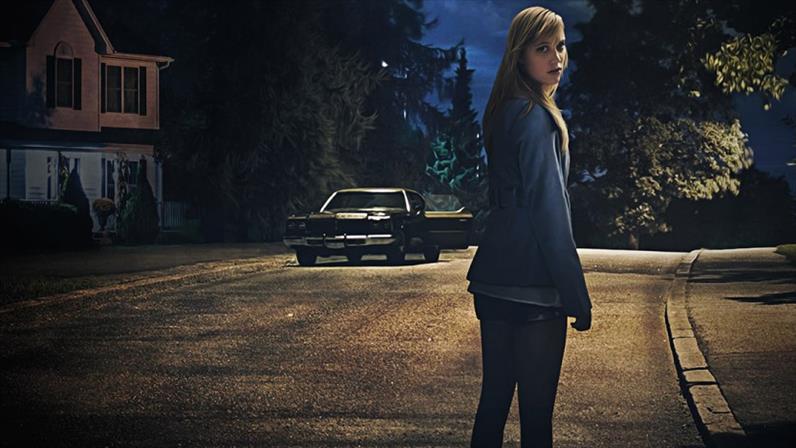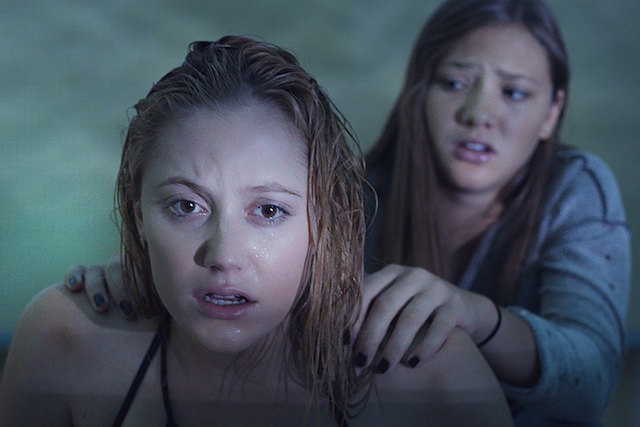
“Creepy, suspenseful and sustained, [It Follows] plays knowingly with genre tropes and yet never winks at the audience, giving it a refreshing face-value earnestness that makes it all the more gripping.”
– David Rooney, The Hollywood Reporter
You’re mine, all mine
Very little in Michigan native David Robert Mitchell’s debut from 2011, the mild-tempered coming-of-age tale The Myth of the American Sleepover, anticipates the formal delectation and genre delights of his follow up, the full on horror film, It Follows (2014). And while both films share a feeling of nostalgia, and a strong, devoted cast of mostly unknowns, playing it point-blank, and selling the setup without omission, It Follows makes no bones with amping up the teenage exploitation angle for far more sinister and messier means.
It Follows is an atmospheric, highly effective old school horror film, complete with a spooky synth-driven score (courtesy of Rich Vreeland, aka Disasterpeace). Set in a decaying Detroit—the perfect, ominous, and almost otherworldly setting—It Follows accompanies 19-year-old Jay (Maika Monroe, sublime in a breakout performance), our relatable, easygoing lead, whose current squeeze, we soon discover, uses her after a romantic night out, to remove a malicious, damnable curse.
The curse is sexually transmitted, a literal, methodical monster with a shape-shifting capacity visible only by those who’ve been similarly vexed. Sound like something from a nightmare? According to Mitchell, that’s exactly right.
“The fears of the unknown, of possession, and sex are personified by the seemingly tortured spirits haunting the chain of the unlucky who chose to be promiscuous with the wrong lover. By the end we don’t know how far back the chain goes; all we know is that it’s walking, and death follows.”
– Drew Tinnin, Dread Central
I have a constant fear that something’s always near

“The idea of being followed by something that is always walking towards you, looks like different people, basically came from a recurring nightmare I had when I was a kid,” says Mitchell during the press junket for It Follows back in 2014. “I’ve never been able to forget some of the feeling from that nightmare, and that was what I built the initial idea upon…Then I added the idea that it could be something passed through sex––that was an element that came much later.”
The not uncommon fear of being relentlessly pursued informs a huge number of horror and suspense classics (prime examples would be Alfred Hitchcock’s North by Northwest [1959], John Carpenter’s Halloween [1978], James Cameron’s The Terminator [1984], and every slasher film you can name), but it’s rare that so familiar a genre standard be used with such simple efficacy as it is here.
And in addition to the waking nightmare aspect of the stop at nothing pursuit, the curse has other potentially pragmatic objectives. For instance, it could one supposes, be an AIDS analogy, but even so, it isn’t presented as didacticism but as inventive and imaginative fright fare of a quality and calibre that’s all too rare, and a real merry-go-round for the midnight movie crowd who would probably appreciate it the most, anyway.
“It could look like someone you know or it could be a stranger in a crowd. Whatever helps it get close to you.”
– Hugh (played by Jake Weary)
One way or another I’m gonna find ya

Set in a non-specific time that feels like the past (it’s fun to speculate when this story occurs as most modern technology is missing, with a few exceptions—movie houses and televisions show old movies like Stanley Donen’s 1963 thriller Charade—and almost no one uses cell phones or computers, except for a bizarre, shell-like e-reader containing Dostoyevsky’s 1869 novel “The Idiot”), the scenarios that play out in It Follows engender legitimate scares.
The murderous spirit that dogs “final girl” Jay initially appears not unlike the ghouls and grudge-holders of J-Horror, but we soon learn that everyone experiences their own personalized pursuer, though most of its appearances remain shrouded in mystery, unexplained and madly unfathomable. By the third act Jay’s tormentor seems to take on the visage of her no-show father––there’s evidence on the periphery of the story that suggests he may be deceased.
The curse often takes the form of alarming, semi-nude prosaic men and blood-flecked women, people you might see just about everywhere that, in an adverse and somewhat surreal context, raise alarms and strike 24-karat terror.
I’m gonna getcha getcha getcha getcha

An anomaly in modern horror, Mitchell takes pains to circle his leading lady Jay with family and friends who are not only responsive to her dilemma, they offer support and sympathy. The supporting characters are admittedly populated with many of the genre clichés you’d expect in such vintage, but the cast are uniformly excellent (Keir Gilchrist, Olivia Luccardi, and Lili Sepe in particular standout), transcending their designations, but the real star here is Mitchell’s flashy, swaggering, dauntless direction.
His 360-degree pans invoke classic Brian De Palma, his widescreen framing conjures distinguished John Carpenter, his tracking shots harken to Stanley Kubrick’s The Shining, and for the second time let’s focus some attention on Disasterpeace’s insistent and artfully unsettling soundscape (the It Follows original soundtrack on vinyl is a rightly coveted collector’s item with good reason).
Sensitive to the nicety and nuance of teenage affections, astutely aware of what horror fans fancy (subversion and reinvention abounds!), It Follows announces the arrival of a new suspense master in Mitchell, and presents us with his first small-scale chef d’oeuvre. Mesmeric, and elegantly otherworldly, It Follows fools with the mind, where it whirls and pirouettes like a semi-dark idol.
Author Bio: Shane Scott-Travis is a film critic, screenwriter, comic book author/illustrator and cineaste. Currently residing in Vancouver, Canada, Shane can often be found at the cinema, the dog park, or off in a corner someplace, paraphrasing Groucho Marx. Follow Shane on Twitter @ShaneScottravis.